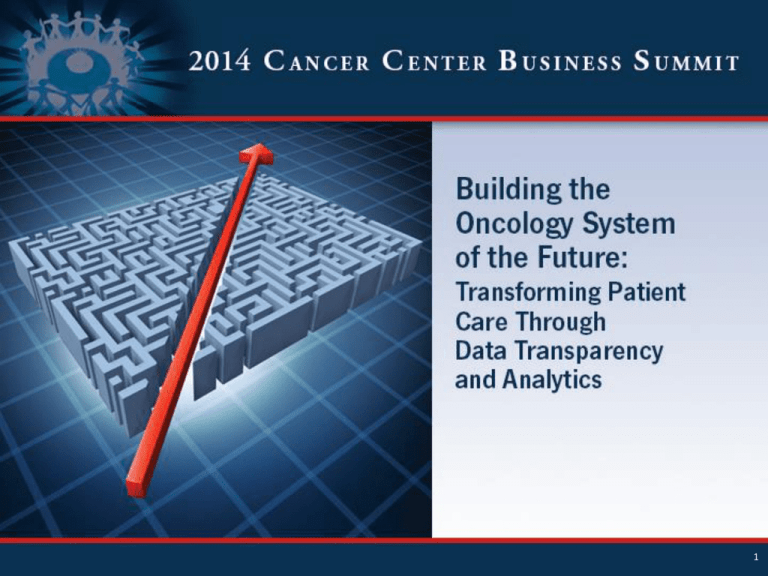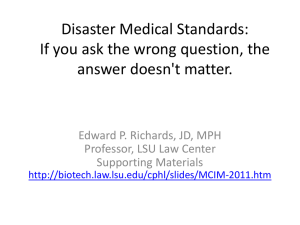
1
Oncologist-Hospital Alignment:
Framing and Transacting the
Relationship
Presented by:
• Michael Blau
Foley & Lardner LLP
mblau@foley.com
617-342-4040
• Scott Herbert, M.D.
New Mexico Cancer Care
scott.herbert@nmcancercare.com
505-660-2627
• Kelley D. Simpson
Oncology Solutions, LLC
ksimpson@oncologysolutions.com
404-836-2000
2
Case Summary
QUALITY CARE ONCOLOGY (pseudonym)
10 Medical Oncologists
4 Locations
4 APPs
2 Radiation Oncologists
2 Linear Accelerators
*1 linear accelerator
in need of replacement
MEMMORIAL CARE Health System and Medical Group (pseudonym)
3 Hospitals
1 340B Provider
Memorial Care Medical Group
Employed Group of 150 with 2MOs and 1 RO
+
= 150
*1 medical oncologist nearing retirement
3
1 Linear Accelerator
Current State: Hospital System Oncology Service Line
FY 2014 Memorial Care - Technical Services
Med Onc
Inpatient
Surg Onc
Inpatient
Onc-Related
Ancillaries
Radiation
Therapy
Infusion
Clinic
FY 2014
TOTALS
1,518
Admits
24 Hrs or >
841
Admits
24 Hrs or >
15,723
23Hr or <
Encounters
400
Courses of
Treatment
600
Med Oncology
New Pts
1,678
Analytic Cases
$38,255,188
$30,993,872
$52,650,701
$23,468,422
$42,972,490
$188,340,673
(24,304,646)
(19,030,218)
(35,357,762)
(16,626,822)
(30,136,816)
(125,456,264)
$13,950,542
$11,963,654
$17,292,939
$6,841,600
$12,835,674
$62,884,409
Less: Direct Costs
(9,584,500)
(7,554,578)
(9,311,928)
(2,789,881)
(7,272,722)
(36,513,609)
Direct Contribution
$4,366,043
$4,409,076
$7,781,011
$4,051,720
$5,562,952
$26,170,802
(3,964,545)
(2,972,134)
(5,792,917)
(1,918,079)
(3,613,199)
(18,260,874)
$401,498
$1,436,942
$2,188,094
$2,133,641
$1,949,752
$8,109,927
Revenue & Expense
Categories
Caseloads/Stats
ICD-9 Codes 140-239
Gross Charges
Less: Non-Collectibles
Net Revenues
Less: Indirect Costs
NET PROFIT/(LOSS)
Per New Cancer Case:
4
$4,833
Current State: Quality Care Oncology Practice
CY 2014 Professional and Technical Services
Medical
Oncology
CY 2014
Radiation
Oncology
E&M Services
Pharmacueticals
IV Admin & Injections
Lab & Procedures
Other
$ 7,559,787
72,161,602
9,758,998
3,161,366
103,089
Simulation
Treatment Planning
Physics & Tx Devices
Treatments
Other
Gross Charges
$92,744,840
Gross Charges
(46,372,420)
Less: Non-Collectibles
Net Revenues
Less: Operating Costs
Staff Salaries & Benefits
Drugs & Biologicals
Rent & Leases
General & Administrative
Operating Costs
Income Distribution to Physicians
$737,292
346,527
1,442,715
7,410,025
860,078
$10,796,638
$103,541,478
Less: Non-Collectibles
(4,858,487)
(51,230,907)
$ 46,372,420
Net Revenues
$5,938,151
$52,310,571
Revenues
$ 5,714,286
31,655,714
1,285,714
1,571,429
Less: Operating Costs
Staff Salaries & Benefits
Supplies
Space & Equipment
General & Administrative
$ 40,227,143
Operating Costs
$3,275,726
$43,502,869
Costs
Net Profit
Less: Rad Onc Comp
Less: 10% RT Ops Budget
Income Distribution Pool
$2,662,425
(1,229,055)
(266,243)
$1,167,127
$8,807,702
(266,243)
$8,541,460
RT Ops Budget
Compensation
$6,145,277
$797,530
43,408
1,940,328
494,460
Per Medical Oncologist
Clinical Compensation: $614,528
RT Distribution:
97,260
Total Income:
$711,788
5
CY 2014
TOTALS
Per Radiation Oncologist
Clinical Compensation: $614,528
RT Distribution:
97,260
Total Income:
$711,788
Always Begin With a Cliché…
“If you know your enemies and know yourself, you
will not be imperiled in a hundred battles…if you do
not know your enemies nor yourself, you will be
imperiled in every single battle.” –Sun Tzu
6
Know Your Enemies…
• Competition landscape
– Other groups in town and state
– Other hospitals in town and state
• Referral patterns
– Primary care vs specialists
– Understand the effect of employment on your referring physicians
– “Care coordinators”
• Payer landscape
– Number of payers
– Are there any payer/delivery system combinations?
– Are you seeing any types of value-based/quality reimbursement projects in your area?
•
Is there interest?
• Community characteristics and demographics
– Community growing/shrinking, changes in age, changes in industry?
– Dominant company providing insurance to its employees? Can this change?
7
Know Yourself…
• Deal timeline
2015
2016
2017
2018
2019
1-2 years to complete and fully operationalize deal
2-3 years to mine meaningful operational
data for the project (financials, productivity, etc.)
– In healthcare, planning 5 years in advance is probably the sweet spot: further
is just not possible, and less doesn’t give you time to accomplish much
• Understand your practice situation
–
–
–
–
–
8
What are the ages and goals of the partners?
If we do NOTHING, what is the outcome and timeline?
How do others see the practice (both the hospital and referring physicians)?
What are your strengths and weaknesses?
What is your asset arrangement and partner equity? Do you have a sound
succession plan?
Develop the “Perfect Practice Environment”
• Paint a clear picture of your desired practice
– Make sure that all of the partners participate.
– Be as specific as possible related to practice environment,
facility structure and workflow, practice patterns (use of
NP’s, research, etc.), ancillary services, and marketing.
– Remember, the model reflects YOUR plans. Don’t let your
plans be dictated by the model.
– Having everyone participate gets crucial buy-in and gives
you a touchstone for difficult times in the future.
9
Attempt to Understand the Hospital’s Perspective
• What are the hospital’s options?
– Are there other groups that the hospital could partner with?
– How strong is the hospital’s medical group?
• Do they recruit and retain with ease?
• What are the hospital’s goals?
– Financial?
– Community opinion/pressure?
– What are the sources of revenue that they are most interested in? You
should be able to calculate volume/contribution of your practice in
relation to each of these areas.
•
•
•
•
•
•
10
Chemotherapy
Radiation
Inpatient admissions
Laboratory/Pathology
Radiology
Surgical oncology
Memorial Care Health System
Strategic, System-Wide Service Line Development
• Leading up to considering alignment with Quality Care Oncology,
Memorial Care:
– An oncology service line 5-year strategic plan
– Initiated a system-wide service line executive and medical leadership
structure
– Branded cancer across the system: “Memorial Cancer Care”
– Embarked on clinical program development/expansion
• Spanning preventive, research, diagnosis and treatment services
through survivorship and end-of-life care
• Surgical sub-specialization and tumor-specific programs with key
surgical recruitments into the Memorial Care Medical Group
– Conducted facilities and technologies assessments and developed
conceptual plans for a single, comprehensive integrated cancer center in
collaboration with Quality Care Oncology
– Launched physician alignment discussions with Quality Care Oncology
Why Hospital-Oncologist Alignment?
• Collaborative Mission
“Memorial Cancer Care fosters a culture of excellence within a
collaborative environment. We actively seek innovative solutions,
technologies and partnerships to support sustainable financial growth
and to ensure communities we serve have access to a comprehensive
continuum of integrated cancer services that meet their present and
future health care needs.”
• Core elements driving integration:
–
–
–
–
–
–
–
Quality
Patient experience/coordination of care
Facility expansion and technologies investment
Competition
Financial integration
Informatics integration
Performance measures and outcomes reporting
DO THE PICTURES MATCH?
13
Hospital Alignment Transaction Process
Goals of the Transaction
Define
• Strategic?
• Business/financial?
Preferred Strategic Partner
Identify
Execute
14
• Serial discussions under Confidentiality Agreements, or
• RFP process, seeking bids to Quality Care’s specifications (requires
Confidentiality Agreement, description of practice, transaction
specifications, opportunity for preliminary due diligence, and
interview process
Standstill Agreement with preferred strategic partner
Hospital Alignment Transaction Process (cont.)
Negotiate
Letter of Intent
Conduct Due
Diligence
Engage
Valuation Firm
• Schedule regular meetings with preferred strategic partner
• Meetings focus on LOI key business terms and transactional hurdles
• During LOI negotiation period, parties conduct preliminary due diligence
- Hospital will issue data request list
- Reverse due diligence?
• During LOI negotiation period, valuation consultant engaged
• Preferably engaged under attorney-client privilege
• Firm issues data request and completes preliminary valuation
Transactional
Consultants Engaged
• During LOI period, other consultants, if any, engaged to provide financial,
operational, technology advisory services
• Preferably under attorney-client privilege (e.g., financial, operational,
technology advisory services)
Establish Operational
Integration Teams
• As necessary to develop preliminary operational integration plans
Finalize Deal
Close Deal
15
• Develop definitive agreements
• Finalize collaborative business plans
• Finalize operational integration plans
• Execute agreements
• Implement the transaction
Principal Structural Options For Transaction
• Convert to Memorial Care
hospital (provider-based)
oncology services (MO
and RO) at all sites
• Convert to Memorial Care
affiliated medical group
oncology services at all
sites
• Convert to Memorial Care
hospital (provider-based)
services for infusion and
radiation therapy only;
and,
• Provide
E&M/consultation
services through either:|
(i) Memorial Care affiliated
medical group, or
(ii) Directly by Quality Care
Oncology
Provider-Based
Services All Sites
16
Memorial Care
affiliated medical
group
Hybrid
Principal Structural Options For Transaction (cont.)
•
Form NewCo joint venture for RT services
– Memorial Care
• Contributes 1 linac and RT staff
• Leases/licenses outpatient space at its 3 hospitals to NewCo
• Memorial Care leases or transfers its 1 rad onc to Quality Care
– Quality Care
• Contributes 2 linacs and staff (other than radiation techs) to NewCo
•
•
•
NewCo sub-leases/licenses space at all sites, linacs and staff to Quality Care in
exchange for a FMV fee
Quality Care provides all ambulatory RO/RT services (globally), and bills/collects for
services under the Stark Law in-office ancillary services exception
Memorial Care provides inpatient services using NewCo and Quality Care services
“under arrangements” OR NewCo contracts with Memorial Care and all
technical/facility fees are billed/collected as HOPD services by Memorial Care; Quality
Care provides professional services with a site of service payment differential
17
Memorial Care Provider-Based Conversion
Value to Quality Care:
Value to Patients:
Value to Memorial Care:
Maintains “independence”
Single treatment
More coordinated
Higher compensation at FMV
environment
oncology services
Elimination of drug
Improved care
Beneficial revenue flow at
inventory/cash flow liabilities
coordination
provider-based rate with
Reduced exposure to
Increased clinical
cost containment within a
reimbursement fluctuations
efficiency
private practice
Eliminates collection risks
340B savings contributes
environment
Purchase of equipment,
to program development
Captive referral source for
management services,
for supportive care
downstream services
employee lease, medical
services, new cancer care
340B pricing opportunity
directorships, co-management
technologies, etc.
New satellite sites
SLIGHTLY
WORSE
18
Potential Losers:
Payers—higher
rates for “same”
services
Higher/double
patient co-pays
Pharma companies
Memorial Care Provider-Based Conversion (cont.)
• Potential Transactional Elements
–
–
–
–
19
Professional Services Agreement (PSA)
Asset Purchase Agreement (APA)
Management Services Agreement (MSA)
Co-Management Agreement (CMA)
Memorial Care Provider-Based Conversion (cont.)
Hospital provides:
• License
• Provider-based status
• 340B pricing
• Space/equipment
• Nurses/techs (off-campus)
Payors
Memorial Care
Professional
Services
Asset Agreement
sale
$/wRVU
Oncology
Sites/Service Line
$
Notes:
• FMV for assets and QC retains cash and A/R
• PSA on fair market wRVU basis (with performance incentives)
• MSA on a fixed fee or budgted cost plus fair market mark-up basis;
•Billing services at fair market percentage of collections or fixed fee per claim
20
Quality Care
Group provides:
• Physicians/NPs/PAs
• Non-clinical staff
• Nurses/techs
(on-campus)
• Management
services?
Affiliated Medical Group Conversion
MCMG provides:
• Space/equipment
• 2 MOs/1 RO?
Memorial Care/
Medical Group
Payors
Professional
Services
Asset Agreement
sale
$/wRVU
Oncology
Sites/Service Line
$
Notes:
• FMV for assets and QC retains cash and A/R
• PSA on fair market wRVU basis
• MSA on a fixed fee or budgeted cost plus fair market mark-up basis;
•Billing services at fair market percentage of collections or fixed fee per claim
21
Quality Care
Quality Care
provides:
• Physicians/NPs/PAs
• Non-clinical staff
•Nurses/techs
•Management
services?
Principal Differences
• No hospital outpatient rates
• No 340 B drug pricing
• Quality Care can provide all staff, including
nurses/techs at off-campus sites
• Quality Care clinicians become part (a Division) of
Memorial Care Medical Group
• Different leadership/governance of Memorial Care
Medical Group than Memorial Care hospitals?
22
Hybrid: Hospital/Affiliated Medical Group Conversion
Memorial Care provides for
infusion/RT services:
• License
• Provider-based status
• 340B pricing
•Space/equipment
MCMG provides:
• 2 MOs/1 RO?
E&M/
Consult
Services
MCMG
Payors
Hosp
Professional
Services
Asset Agreements
sales
$/wRVU
Infusion/RT
Services
$
Quality Care
Notes:
• 2 APAs: FMV for assets and QC retains cash and A/R
• 2 PSAs (with Hospital and MCMG) on fair market wRVU basis
• 2 MSA (with Hospital and MCMG) on a fixed fee or budgeted cost plus fair market mark-up basis
• 2 Billing service agreements (with Hospital and MCMG) at fair market percentage of collections or fixed fee
per claim
23
Quality Care
provides:
• Physicians/NPs/PAs
• Non-clinical staff
•Nurses/techs
•Management
services?
Principal Differences
• Hospital outpatient rates for infusion/RT only;
physician office rates for E&M/consult services
• “Separation” issue for licensure purposes?
• Lower co-pay on E&M/consult services
• 340B drug pricing available
• Quality Care cannot provide nurses/techs (under
MSA) for infusion services at off-campus sites
• Quality Care clinicians become part (a Division) of
Memorial Care Medical Group for E&M/consult
services
• Need to coordinate governance with multiple parties
24
Principal PSA/Conversion Legal Issues
• Fraud & Abuse/Tax Exemption
• Under arrangements prohibition: cannot have investment
interest in entity (including own medical group) that
“performs” the DHS service
• Assign leaseholds/Sell equipment?
• Stark Law personal services, fair market value or indirect
comp exception
• Some irreducible AKS risk: aggregate compensation not set
in advance if wRVU based
• Tax exemption and reasonable compensation
• Key to compliance is fair market value and commercial
reasonableness--independent appraisal strongly advised
25
Principal PSA/Conversion Legal Issues (cont.)
• Additional Tax Exemption Consideration
– Rev. Proc. 97-13 and private use of bond financed space or
equipment/duration limitations (3 years/2 years out)
• Provider-Based Status Regulations
–
–
–
–
–
26
Within 35-mile radius
Hospital license requirements/Physical space standards
Clinically, financially and administratively integrated
Hospital reporting lines
Hospital must directly employ mid-levels/techs at offcampus sites (other than NPs/PAs)
Principal PSA/Conversion Legal Issues (cont.)
• 340B Drug Pricing
– Discount from average manufacturer price generally based
on manufacturer’s best price
– Applies only to outpatient drugs
– Available to DSH hospitals, free-standing cancer hospitals,
children’s hospitals, CAHs, RRCs, sole community hospitals,
FQHCs, and certain special federal grantee programs
– 8% DSH for RRCs and SCHs; 11.75% for others
– Not applicable to for-profits
– Must be within 35 miles of main hospital/meet providerbased status standards
– Effective after first cost report filed with CMS and
enrollment with HRSA/OPA—up to 16 month process
27
Key PSA Deal Maker/Breaker Issues
•
•
•
•
•
•
•
•
•
•
Strategic Alignment
Trust/Relative Trust
Governance
Financial Terms/Valuation
Right of First Opportunity
Addition of New Clinicians
Term/Duration/Termination
Restrictive Covenants
Unwind Rights
Arbitration/Dispute Resolution
28
Combined PSA/Service Line Co-Management
Arrangement
• Co-Management Agreement is an additional
independent contractor relationship
– PSA purchases professional services of physicians and
clinicians
– Co-Management Agreement purchases administrative and
management services from physicians and clinicians
– Engage physicians as a business and clinical partner in
managing, overseeing and improving service line quality
and efficiency
– No overlap in contractual duties between PSA and CoManagement Agreement (or other agreements)
29
Service Line Co-Management
Direct Contract Model
Designees
Payors
Hospital
Service
Line
Hospital-licensed
services
30
Operating
Committee
$
• Two, or multi-party
contract
• Specifically enumerated
services
• Allocates effort and
reward between groups
Designees
Oncology Group
Group II
Other
Group(s)
Service Line Co-Management
Joint Venture Model
Hospital
Payors
Profit
Distribution
$
Service
Line
31
Specialists/
Groups
Profit
Distribution
JV
Management
Company
• Capital Contributions
• Management Infrastructure
Service Line Co-Management Arrangements
• Typically two levels of payment to physician managers:
– Base fee – a fixed annual base fee that is consistent with the
fair market value of the time and effort participating
physicians dedicate to service line development,
management, and oversight
– Bonus fee – a series of pre-determined payment amounts,
each of which is contingent on achievement of specified,
mutually agreed, objectively measurable, program
development, quality improvement and efficiency goals
– Aggregate payment generally approximates 2-3% of service
line revenues
• Fixed, fair market value; independent appraisal advisable
32
CMA Legal Considerations
• There are legal constraints on Service Line
Co-Management Agreements (i.e., CMP, AKS and Stark):
–
–
–
–
–
–
–
–
33
No stinting
No steering
No cherry-picking
No gaming
No payment for changes in volume/referrals
No payment for quicker-sicker discharge
No reward for changes in payor mix, case mix
Must be FMV; independent appraisal required
CMA Legal Considerations
• Adv. Op. 12-22 approving co-management
arrangement
• Some irreducible legal risk because aggregate
compensation is not set in advance
• Minimize legal risk by:
–
–
–
–
–
–
34
Internal monitoring with compliance officer review
Independent FMV appraisal
Independent outside reviewer
Good contract
Good execution
Good documentation
Radiation Therapy Joint Venture
Memorial
Care
Quality Care
Payors
•
• Space
•RT equipment
•Leasehold
improvements
•Non-clinical staff
NewCo
LLC
Quality Care
RT Center
Technical Service
Agreement
• ROs/RTs
Notes
• New sites or upgrade vs. existing sites/services
•NewCo cannot “perform” the technical component of the RT services
•Constraints on non-profit/for-profit JVs
• Technical Services Agreement payment must be FMV, but can be percentage-based if
structured to be outside of Stark Law
•Antitrust considerations: market concentration and joint pricing
35
Physician office
rates
Radiation Therapy Joint Venture
• NewCo could contract with either Quality Care or
with Memorial Care
• If NewCo contracts with Memorial Care
– Within Stark Law—can’t be per-click or percentage of
revenue fee for space/equipment
– Site of service differential on pro fees if professional
services
36
Deal Killers
• Compare the pictures
• Physician champion (the sacrificial lamb)
• List at the beginning, never waiver, never add to the list.
– Examples:
• Dictating referral patterns
• Research
• Upper-level management HR control
37
Common Pitfalls (with catchy names)
• “Who’s this guy?”
– Deal negotiator hands off to the implementation team
• “Everybody’s from Missouri: The Show-Me State”
– During implementation, “hospital regulations” become an often cited
reason to do things the hospital way
• “Can I borrow some data for that?”
– The practice is responsible for metrics that depend on accurate and timely
data from the hospital
• “The apple doesn’t fall far from the tree”
– Who’s culture will prevail in the oncology clinic (front desk, nursing, back
office, etc.)?
• “It’s not broken enough to fix”
– Will the hospital be interested in, and continue to fund, practice
improvement if the bottom line is already met?
• If possible, address these issues in the Letter of Intent
38
Issues Related to Deal Structure
• You may want as many moving pieces as possible:
Management agreement, professional services
agreement, employee lease, co-management
agreement, medical directorship, call agreement,
billing agreement, real estate ownership/leases, etc.
• Ownership and control of employees
– Location of clinics (on vs off campus)
– Employee benefits
39
Consequences and Back-up Plans
• What is your exit strategy?
– If this fails, you will likely become an employee (or a
consultant).
– Could you partner with someone else?
– Are you willing to buy back your assets?
• Asset allocation
– Patients
– Office space (buildings, leases, etc.)
– Equipment (radiology equipment, linear accelerators, lab, etc.)
40
Quality Care Financial Elements of the Transaction
Executing
Professional
Services
Agreement
• Clinical compensation
for professional medical
and radiation oncology
services at FMV rate
per wRVU
• Percentage (usually 520%) of clinical
compensation reliant
upon performance
metrics
$8,541,459
($711,788 per MD)
To
$9,822,678
($818,557 per MD)
41
Valuing
Existing
Technical
Business
Streams
• Value and buyout of
the ongoing technical
businesses of radiation
therapy, imaging, lab,
retail pharmacy and
clinical trials
• FMV payment/buyout
at calculated multiple of
EBITDA within industry
comparatives and
standards
• No buyout of RT
• Lab and research
valued at $500,000
Executing
Billing and
Management
Services
Agreements
Billing services
Management services
Medical leadership svcs
FMV payment for medical
leadership at comparable
industry hourly rates
• FMV payment for billing
and management services
at % above cost within
industry standards
•
•
•
•
≈$3,250,000
Defining
Additional
Potential Ops
& Financial
Arrangements
• Space purchase or lease
• Durable medical
equipment and
furnishings asset
purchase or lease
• Staff employment or
lease
• FMV payment for
purchase or lease
arrangements based on
industry comparatives
Dependent upon
purchase vs lease
decisions
Current State: Hospital System Oncology Service Line
FY 2014 Memorial Care - Technical Services
Med Onc
Inpatient
Surg Onc
Inpatient
Onc-Related
Ancillaries
Radiation
Therapy
Infusion
Clinic
FY 2014
TOTALS
1,518
Admits
24 Hrs or >
841
Admits
24 Hrs or >
15,723
23Hr or <
Encounters
400
Courses of
Treatment
600
Med Oncology
New Pts
1,678
Analytic Cases
$38,255,188
$30,993,872
$52,650,701
$23,468,422
$257,109,475
$402,477,658
(24,304,646)
(19,030,218)
(35,357,762)
(16,626,822)
(146,433,018)
(241,752,466)
$13,950,542
$11,963,654
$17,292,939
$6,841,600
$110,676,457
$160,725,192
Less: Direct Costs
(9,584,500)
(7,554,578)
(9,311,928)
(2,789,881)
(81,864,314)
(111,105,201)
Direct Contribution
$4,366,043
$4,409,076
$7,781,011
$4,051,720
$28,812,143
$49,419,993
(3,964,545)
(2,972,134)
(5,792,917)
(1,918,079)
(5,829,034)
(20,476,709)
$401,498
$1,436,942
$2,188,094
$2,133,641
$25,198,944
$31,359,119
Revenue & Expense
Categories
Caseloads/Stats
ICD-9 Codes 140-239
Gross Charges
Less: Non-Collectibles
Net Revenues
Less: Indirect Costs
NET PROFIT/(LOSS)
Per New Cancer Case:
42
$18,688
The Deal is Done…What Next?
• Implementing the relationship, beginning with
establishment of a Joint Operating Committee
• Immediately following this session Track A at 11:30am
43
QUESTIONS?
44









